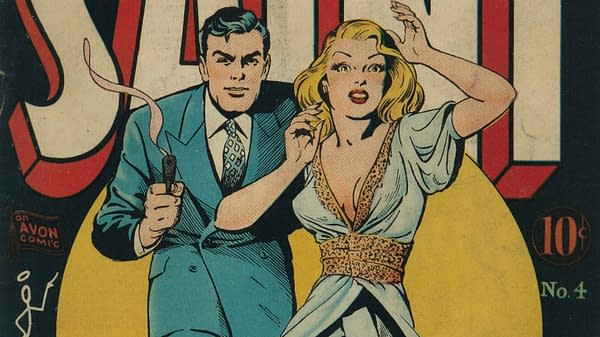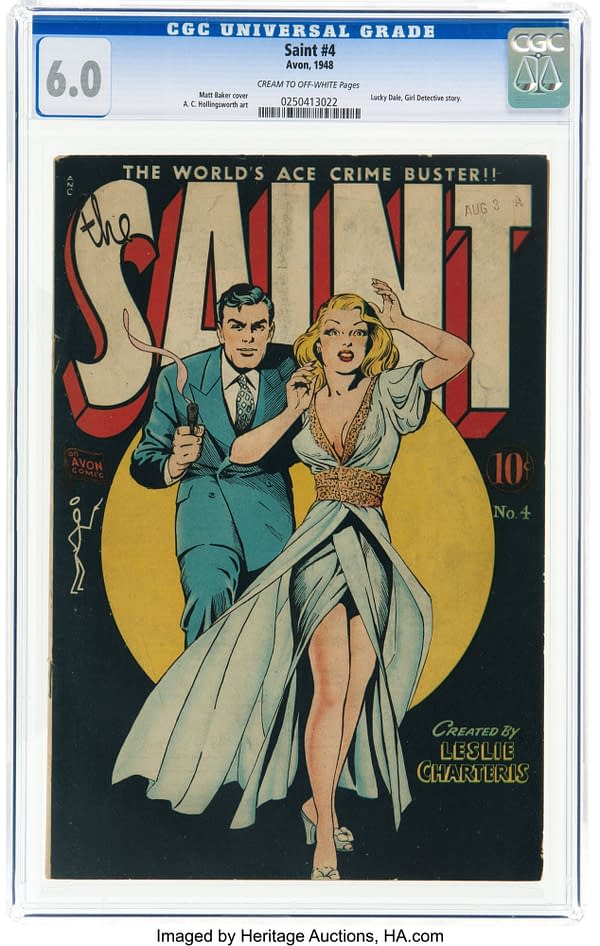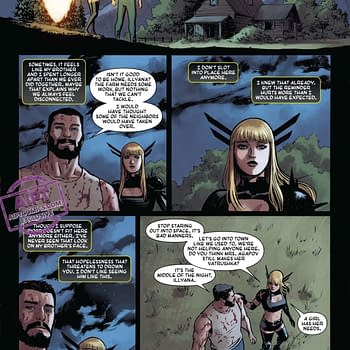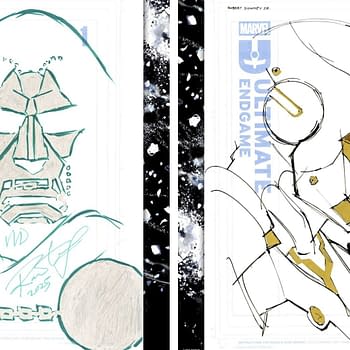Posted in: Comics, Heritage Sponsored, Vintage Paper | Tagged: golden age, Matt Baker, The Saint
Leslie Charteris and the Mystery of Avon's The Saint #4, at Auction
Cover art for Avon's The Saint #4 has been the subject of debate in recent yrs, but style & circumstances still make Matt Baker a possibility
Article Summary
- Leslie Charteris' critical feedback may explain art revisions and multiple artists for The Saint series covers.
- Historical challenges of publishing The Saint in comics, including artist and licensor issues.
- Possibility that existing Charteris archives may uncover more clues about The Saint #4 cover.
- Debate surrounds the creation of iconic The Saint #4 cover; Matt Baker remains a strong possibility.
Avon Publications' Joseph Meyers had been in the business of publishing paperback editions of Leslie Charteris's highly successful The Saint book series for years when he wrote Charteris about the idea of a comic book featuring the character in 1944. While Meyers, mindful of wartime paper regulations, pitched the title as a potential quarterly in 1944, it appears that Charteris preferred to wait until it could be published monthly. But significant newsprint shortages continued after the war, perhaps accounting for the mid-1947 launch date of Avon's The Saint comic book a year and a half after wartime paper restrictions had ended. The title never did make it to the planned monthly release schedule. That was just the beginning of what seems to have been a somewhat problematic production for the series, and that might help explain the mystery behind the cover of The Saint #4. An iconic late Golden Age cover, there's a The Saint #4 (Avon, 1948) CGC FN 6.0 Cream to off-white pages up for auction in the 2024 July 18 The Matt Baker Comics Showcase Auction #40267 at Heritage Auctions.

There's been a debate in recent years over who really drew the cover of The Saint #4. While many have credited it to Matt Baker over the years, some experts have disagreed. Notably, GCD has also tentatively identified Baker on the Lucky Dale feature in The Saint #1. While it seems clear that there are many hands here and not all of the art in this feature in this issue can be Baker, it's also fairly obviously a light reworking of the Lucky Wings feature concept from Atomic Comics with an identical lead character, which Baker worked on for the cover of Atomic Comics #4. Combined with the Kamen work on that debut issue of The Saint, there would seem to be some Iger Studio involvement here, which opens up some potential possibilities for the cover of The Saint #4.
While one can perhaps point to some stylistic reasons that argue that The Saint #4 cover might not be Baker work, there seems to be no other artistic candidate that is a better fit than Baker. Of the artists with known cover credits for the series, none is a particularly good fit for this one. In terms of the possibility of other artists of the period, Lee Ames as a candidate is not impossible, though Baker still seems a much better overall stylistic fit. The possibility that this cover could have emerged from Iger Studio might also help explain some things. But there might be a reason why the cover artist for this piece is more difficult to identify than usual while accounting for the undeniably "Bakerish" aspects to the piece overall, as well as Baker's involvement.
The Challenges of Drawing The Saint
Letters and other info in The Saint, A Complete History in Print, Radio, Film and Television of Leslie Charteris' Robin Hood of Modern Crime, Simon Templar, 1928-1992 suggests that Charteris did not have approval over the finished comic books of this Avon series. Putting the correspondence dates on a timeline implies that he was given proofs just as the issue was going to press, and he would provide feedback in regards to his preferences for future issues from these proofs. It appears that Charteris gave detailed feedback on the dialog and artwork of each issue (plot synopses were provided farther in advance) He may have approved individual artists or character styles based on samples. Comments from Charteris regarding the stature and glamour of the Saint and his female companions vs other characters seem to have been common in the early going.
By 1947, Charteris was also getting a The Saint comic strip underway with the New York Herald-Tribune, and his detailed feedback to artist Lew Schwartz regarding what seems to have been early samples or character designs for the strip led to a contentious exchange. In response to a late-1947 missive from artist Schwartz (who was drawing Batman for DC Comics around this same time), Charteris responded (in part):
I'm sorry that you react so violently to criticism, but I'm afraid you're going to have to get used to the idea at least until you are generally accepted as the dean of comic strip artists. In fact, it may still go on after that, if I can judge from my own experience, since I still get plenty of criticism from many quarters.
It's rather silly of you to maintain that you will draw hands as you goddam please, because you won't.
Anyone with experience in producing licensed comic books will tell you that such contention between licensor and publisher is far from uncommon. Both parties want to get it right and have specific but sometimes conflicting ideas on how that should be accomplished. The reality of licensed comic books is that work sometimes has multiple hands involved, goes through multiple revisions, or that artists are sometimes compelled to stray from their usual style of drawing hands (or faces, or what have you). Sometimes, a publisher is forced to cast a wide net to find a style that the licensor will like, and who better in 1947 as a potential candidate for having a glamourous, polished style than Matt Baker? The cover of The Saint #4 is simple, focuses on the figures and has the earmarks of a pitch sample. It might have even been repurposed by the artist from a pre-existing unpublished piece. It may also be noteworthy that this cover would have appeared around the same time as Baker's earliest work for St. John, and thus might have been part of his bid to find work as he entered the post-Iger stage of his career.
Based on what's been established about Charteris's feedback, one can easily imagine him replying with something like "the woman's face should be more full" or "The Saint should be pointing a gun here rather than letting his arm hang down by his side", resulting in art revisions on the part of Avon. That's just speculation, but the evidence suggests that Charteris was never satisfied with the cover art of The Saint comic book series. Four of the final six covers used previously-approved painted artwork from Avon's The Saint paperbacks, with the other eight covers credited (some tentatively) to seven different artists.
Joseph Meyers and Avon's Publishing Challenges
Avon's Joseph Meyers had a history of going to great lengths to get what he wanted in publishing, and it's not unlikely that he prepared to enter the comics field with Molly O'Day in 1944 with the ultimate intent of publishing The Saint comic books, seemingly undaunted (or perhaps unaware) that another significant effort had been made which ended in failure just two years prior. Publisher Lev Gleason apparently had a lot riding on the appearance of The Saint in his flagship title Silver Streak Comics noting in an editorial, "I have spared no expense to give you the very best. We lead off in this issue with The Saint by Leslie Charteris. As far as we know this is the most expensive feature ever to appear in a comic magazine."
Gleason's expensive gamble didn't pay off. The Saint had started in Silver Streak Comics #18, and three issues later (and one issue after Gleason had boasted about how much he was paying Charteris to get The Saint in comics) the title was dead — to be replaced by a completely different and even more legendary title that picked up its numbering two months later with Crime Does Not Pay #22. Perhaps tellingly, Gleason had even sidestepped the issue of acceptable cover art entirely in the characters' second and final Silver Streak cover appearance by simply starting the story on the cover.
Meyers may have been unphased by such problems, having run through a gauntlet of difficulties during the rise of Avon Publications. The publisher traces an interesting path through the history of the cheap mass market collected and reprinted edition in America. The oldest thread of the company began under publisher John Stuart Ogilvie who started his own publishing firm, best known as J.S. Ogilvie Publishing Company or J.S. Ogilvie & Co., in 1868. After John Stuart Ogilvie's 1910 death, the firm passed onto his sons Donald and Frank, who seem to have remained in charge of the company until their own deaths in 1936 and 1937 respectively. By this time, the company maintained a back catalog of self-help, "home study" and a dizzying array of other non-fiction and fiction titles in clothbound and various formats of softcover editions with a heavy mail-order sales presence.
At this point, the company came under the control of Joseph Meyers and his sister Edna Meyers Williams. Meyers and Williams had run publishing businesses beginning around 1928 with Illustrated Editions Company and related companies. According to Meyers' 1943 testimony in Pocket Books v Avon, he had been in the book business in some form since 1923. By some accounts, American News Co. subsequently helped fund Meyers' 1941 transformation of J.S. Ogilvie into the paperback publisher Avon. But whatever role ANC might have played in this scenario, the resulting distribution arrangement would soon become frayed. From 1953 to 1956, Avon and ANC would engage in a series of lawsuits over Avon's use of the separate corporate entity Avon Book Sales Corporation in what ANC construed as an end run around their exclusive distribution contract.
Given the glimpse at the level of detail regarding the ongoing development suggested in The Saint, A Complete History, it seems likely that details about the circumstances of this cover exist in the Charteris archives, somewhere. But for now, the circumstances and stylistic elements would seem to suggest that Baker's involvement in this cover is certainly possible, and perhaps more likely than not. That's a long way from a smoking gun, but absent records, tentative attributions will continue to evolve over time. In the meantime, it's a gorgeous and iconic cover from the late Golden Age era, and there's a The Saint #4 (Avon, 1948) CGC FN 6.0 Cream to off-white pages up for auction in the 2024 July 18 The Matt Baker Comics Showcase Auction #40267 at Heritage Auctions.

















